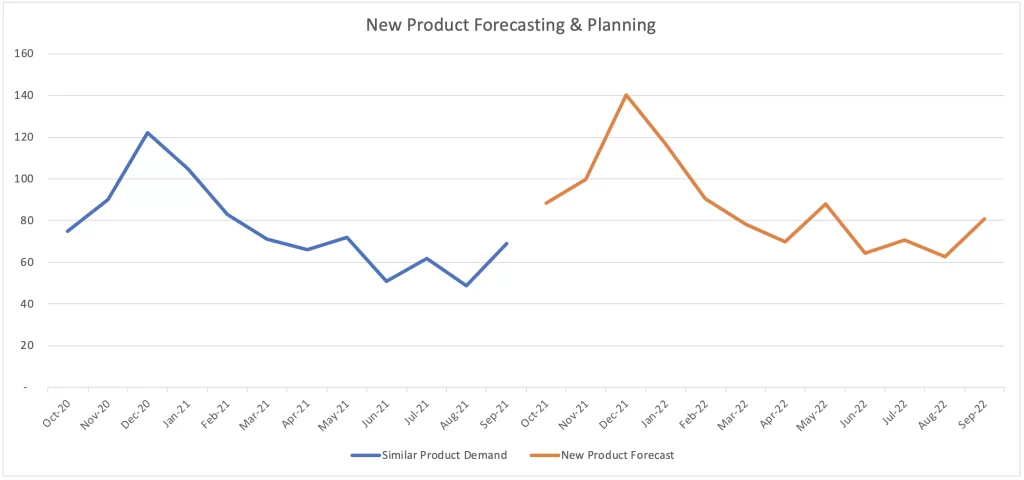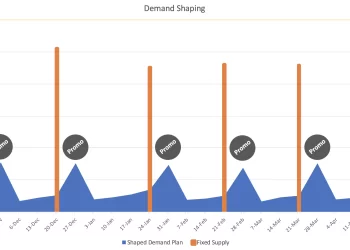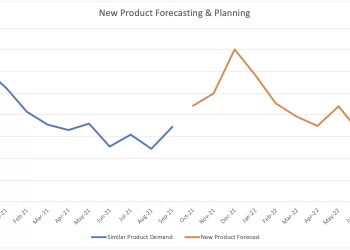How to Effectively (and Accurately) Forecast and Plan for New Product Demand

Innovation and new product development are no longer nice-to-haves for organizations that operate in the fast-paced and competitive global market. To maintain relevancy, growth, market share, and brand recognition while continuing to deliver value to customers and surviving seasonality, demand spikes, supply shortages, and macroeconomic swings, innovation and new product development are critical must-haves.
One challenge with new products, however, is determining how much to produce without any historical data to base your production or delivery metrics on. Get it wrong, and you can damage your reputation and miss your first-mover advantage. Getting it wrong can also leave you with finished goods you cannot sell – goods that take up costly warehouse space and create cash flow problems for your organization. Get it right, however, and you can revitalize your brand, create new blue oceans of untapped markets, and deliver value to customers while generating business profits.
Here we talk about how to forecast demand for your new products, what questions to ask when developing a prediction model, and what steps to take to ensure that your forecasting efforts reap positive results for your new product and your company.
Before Selecting a Forecasting Model
Your choice of forecasting model will depend on several things. These include the context and business situation for which you are forecasting, how relevant and easily available historical data is, the degree of accuracy required, the timeframe of the forecast, and the costs/resource requirements needed to perform forecasting analysis.
Before selecting a model, ask yourself the following:
- What are the goals of the forecast?
- How will the figures or conclusions arrived at be used?
- How quickly is a forecast needed?
- Are you forecasting a few weeks, months, or several years into the future?
- What is the forecasting budget?
- What kinds of historical or comparable market data are available?
Forecasting techniques vary in cost and accuracy, and some methods are better suited to certain situations than others. For example, forecasting sales to determine the right company-level business strategy may rely more heavily on macroeconomic cycle analysis than, say, forecasting for POS sales strategies for initiatives such as localized promos.
Once you have answers to the questions above, you will be able to choose one of the forecasting models below.
Forecasting Models
Qualitative Forecasting
Remember: You can only forecast after you have formulated your problem statement and know why you are forecasting and for what timeframe. Thereafter, once you have your goal, budget, and data ready, you can choose a method.
Qualitative data such as expert opinions can be used for new product forecasting since sales data will essentially be nonexistent (or, at best, only qualitatively similar to what you need). Business teams such as your marketing, analytics, and strategy teams can use their judgment and experience along with rating systems to make contextual assumptions on what they think will happen and why. This will help them convert qualitative information into number estimates for sales.
Zero-based forecasts are an example of qualitative forecasting. For new products that have no historical sales, you must build your forecast from scratch without any baseline. You can use data from a similar product (an in-house product or a competing product) and the expertise of your forecasting team (or the assistance of an external consultant) to project product demand.
Time Series Analysis
Time series analysis uses historical data to identify trends, correlations, cycles, and other factors that affect demand so that patterns can be identified. Demand can then be projected based on the assumed impact of relevant factors.
Causal Models
Causal models use information similar to that used in time series analysis along with observed relationships between different elements as seen in qualitative forecasting. Combined, they are used to create powerful, data-driven forecasting models.
Getting the Technical Aspects of Forecasting Right
Here we talk about getting the technical aspects of forecasting right.
Forecast Initial Sales Volumes for New Products
Use relevant data points to forecast the initial sales volumes of new products that have little or no history. Look at:
- Historical sales data on similar products in the same category.
- Current sales data from competing products.
- Marketing data from POSs, promos, campaigns, and coupons.
- The likely impact of seasonality (such as holidays) on immediate sales.
This data can help you develop a ballpark range for sales for the first three months or so after the new product is launched.
Finalize Your Initial Production Run
Your first production run will usually be about 70% of the projected initial sales volume. The type of product also matters, however. Products with a short shelf life will have a lower percentage than long-lasting durables. Adjust your initial production run accordingly.
Monitor Sales and User Feedback
The first few weeks after a new product launches are the most critical. Closely monitor feedback from customers, retailers, distributors, and other players along your supply chain. Integrate POS data with relevant supply chain metrics to better understand sales and delivery activity. This will help you manage backorders as well as resource procurement and production so that you can maintain sales.
Forecasting Best Practices
Here are a few recommendations and best practices that can help you effectively create, roll out, monitor, and manage new product forecasts.
Get Everyone On Board
Identify key resources from your marketing, sales, supply chain, and operations teams who will be tasked with developing and managing the forecasting (and reforecasting) process from launch through to when demand planning and forecasting become predictable.
Clearly Define and Agree On Assumptions
Gather and review whatever qualitative and quantitative data you can through market research, testing, and surveys. Create a set of assumptions on which your forecasting model will be designed. Your forecasting team will likely need to make assumptions about:
- The size of the target market.
- The target market’s willingness to buy.
- When they will buy.
- What kinds of repeat and replacement purchasing to expect.
You may need additional research or the help of a consultant or industry experts to fill any important information gaps.
Use Flexible Forecasting Periods
While you may want to have a sales forecast for the first three months after launch, it helps to have projections for the first month, the first week, and the first few days after launch since sales figures over shorter periods may vary widely from your three-month average.
Forecast in Ranges
Tweak your figures and run your models a few times to generate a range of possible outcomes which you can use to plan resource requirements and distribution. This will help you avoid being caught unprepared with demand numbers that are way off your baseline projections.
Reforecast
Closely monitor sales and any other qualitative feedback you have access to such as customer reviews and social mentions to determine how accurate your forecasting model is and whether any of your assumptions need to be changed. If appropriate, you can even reforecast daily based on new data.
Improving Accuracy for New Product Forecasts
With over 15 years of experience in supply chain consulting, the Causometrix team can help you with demand management and forecasting, collaborative planning, inventory optimization, budgeting, demand lifecycle management, and more. With our platform, you can reduce excess stock, minimize stockouts, improve service levels, and optimize planning accuracy with our proprietary self-learning AI/ML engine.
We work with industrial manufacturing businesses as well as organizations operating in the medical device, chemicals, merchandising, plumbing supplies, book publishing, automotive, pharmaceutical, and apparel industries.
Learn more by contacting one of our Supply Chain Planning Solutions Specialists at https://www.causometrix.com/contact-us.
Topics: Causometrix, Demand forecasting, New Product Forecasting, NPI
Written by Jamsheed Iqbal
Topics:
Recent Posts
-
Best Practices for Demand Sensing, Demand Shaping, & Influencing Demand
Despite vast improvements in the tools and techniques available today for demand sensing and demand shaping, a lack of forecast accuracy still prevents many businesses from optimally managing production, distribution, inventories, and sales to meet shifts in demand. This is often because:
October 12, 2021 Read more -
How to Effectively (and Accurately) Forecast and Plan for New Product Demand
Many businesses, large and small, have a huge source of great ideas that can help them improve, innovate, and grow, and yet so many of these companies never think of using this amazing corporate asset. What is this highly valuable asset? Its own people.
September 28, 2021 Read more -
How to Measure your Demand Forecasting Accuracy
Many businesses, large and small, have a huge source of great ideas that can help them improve, innovate, and grow, and yet so many of these companies never think of using this amazing corporate asset. What is this highly valuable asset? Its own people.
July 13, 2021 Read more
Subscribe to email updates from Causometrix!
Stay up-to-date with Causometrix


